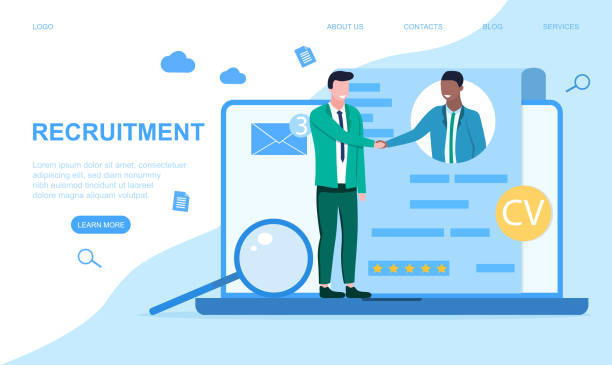Introduction to the Importance of User-Friendly Website Design in Today’s Digital World

In this era, where the internet has become an inseparable part of our daily lives, merely having a website is no longer enough.
What truly makes a difference is its #user_friendly_website_design.
A user-centric website not only attracts visitors but also encourages them to spend more time on your site and convert into loyal customers.
User-friendly website design means creating a smooth, pleasant, and hassle-free experience for everyone who interacts with your website.
This includes visual layout, loading speed, navigation simplicity, and accessibility for all users.
The importance of this effective website design stems from the fact that today’s users are very impatient, and if they encounter any complexity or problem, they quickly leave your site and go to your competitors.
Therefore, investing in a website with an excellent user experience is a strategic decision for any business.
Next, we will explain the various dimensions and key principles of effective website design and provide practical guidelines to achieve this goal.
This section is explanatory and educational to gain a deeper understanding of the concept and why this topic is important.
Is your company’s website as professional and trustworthy as it should be? With specialized corporate website design by Rasawweb, create an online presence that reflects your credibility and attracts more customers.
✅ Build a powerful and professional image for your brand
✅ Convert visitors into real customers
⚡ Get a free consultation now!
Key Principles of User Experience (UX) in Website Design

User Experience, or #UX, is the backbone of a successful user-friendly website design.
Beyond mere aesthetics, UX addresses how a user feels when using the website.
Key UX principles include Usability, Accessibility, Desirability, and Findability.
Usability means that the website should be easy to use and users should be able to complete their tasks without confusion.
This includes intuitive navigation, simple forms, and clear feedback.
Accessibility ensures that the website is usable for individuals with special needs, such as those with visual or motor impairments.
Is your website accessible to everyone? This is an important thought-provoking question you should answer.
Desirability addresses emotional and aesthetic aspects; do users enjoy interacting with your site and have a positive experience? And finally, Findability refers to the ease of finding information and content on the site.
To achieve a truly user-friendly website design, these principles must be considered at every stage of development.
This section provides a specialized guide for a deeper understanding of the connection between UX and effective website design.
Responsive Design and Its Importance in User-Friendly Websites

In today’s world, where users access the internet from various devices, #responsive_design has become an undeniable necessity for any #user_friendly_website_design.
This approach ensures that your website displays correctly and provides a consistent user experience regardless of screen size (from small mobiles to large desktops).
The absence of responsive design can lead to high bounce rates, poor search engine rankings, and ultimately, loss of customers.
Google also places great emphasis on this issue and prefers mobile-friendly websites in its search results.
This aspect of effective website design not only enhances user convenience but is also crucial for SEO.
Imagine a user trying to read your content on a smartphone, but the fonts are too small and they need to constantly zoom in; this experience will quickly frustrate them.
Therefore, a user-centric website must be responsive.
Below is an analytical and educational table for a better understanding of breakpoints in responsive design:
| Screen Size | Device Type (Example) | Design Changes |
|---|---|---|
| Less than 576px | Smartphones (Portrait) | Hamburger menu, single-column layout, larger font for readability |
| 576px to 768px | Smartphones (Landscape) and Small Tablets | May become two-column, medium font size, improved touch interaction |
| 768px to 992px | Tablets (Portrait and Landscape) | Multi-column layout, full menu display, larger elements |
| 992px to 1200px | Laptops and Small Desktops | Standard desktop layout, more UI details |
| More than 1200px | Large Monitors and Wide Desktops | More space, richer visual details, more complex layout |
Content Strategy and Its Impact on User Engagement

Content is king, and in #user_friendly_website_design, this statement holds true more than ever.
A website with rich, relevant, and valuable content not only attracts users but also keeps them engaged for longer.
Content strategy should go beyond simply writing text; it should include planning for content types (text, image, video, infographic), tone of voice, and the purpose of each content piece.
Your content should answer users’ questions and address their needs.
Is your content designed to make users think critically or does it merely provide raw information? Providing #thought_provoking_content can significantly increase user interaction.
For example, using storytelling and real-life scenarios can provide an engaging experience for the user and help them better understand the topic.
The ultimate goal is for users to feel that they have easily found the information they need and are satisfied with its quality.
Additionally, clear and attractive calls to action guide users toward next steps, such as purchasing a product or subscribing to a newsletter.
This section is a comprehensive guide for developing your user-centric website’s content strategy.
Does your current corporate website not reflect your brand’s credibility and power as it should? Rasawweb solves this challenge for you with professional corporate website design.
✅ Increase credibility and visitor trust
✅ Attract more targeted customers
⚡ Click for a free consultation!
Aesthetics and Its Role in User Experience

Website aesthetics, which include color scheme, typography, white space, and images, play an undeniable role in creating a #user_friendly_website_design.
The first thing a user notices when entering your site is its visual appearance.
An attractive and harmonious visual design can convey a sense of trust and professionalism, while a cluttered or outdated design can lead to distrust and quick site abandonment.
The importance of this issue is such that many users judge the credibility and quality of a business based solely on the website’s appearance.
Proper use of color theory and typography not only improves readability but also evokes specific emotions in the user and influences their decision-making.
Sufficient white space makes elements more readable and prevents visual clutter, which directly impacts ease of navigation and content comprehension.
A user-centric website strikes a balance between beauty and functionality.
This section is a specialized and explanatory guide showing how visual elements contribute to forming an excellent user experience.
Optimizing Speed and Performance to Retain Users

Website loading speed is one of the most important factors in #user_friendly_website_design and #SEO.
Today’s users are accustomed to speed and expect websites to load within a few seconds or even less.
Every millisecond of delay can mean losing a visitor.
Studies have shown that increasing loading time by just one second can increase bounce rate by up to 20% and decrease conversion rate by up to 7%.
This is crucial news for any business focused on its online presence.
Image optimization (compression without loss of quality), using a CDN (Content Delivery Network), caching, and minimizing CSS and JavaScript codes are among the key methods for increasing website speed.
Also, choosing a powerful and suitable hosting provider plays a significant role in this area.
Tools like Google PageSpeed Insights help you to #analytically assess your website’s performance and identify weaknesses.
Learning Core Web Vitals principles from Google is crucial for evaluating your website’s performance.
These factors not only affect user experience but also your search engine rankings, and therefore, are essential for a website with an excellent user experience.
Website Accessibility: Designing for Everyone

Accessibility in #user_friendly_website_design means that your website should be usable by everyone, regardless of their abilities or disabilities.
This includes individuals with visual, auditory, motor, or cognitive impairments.
Creating a website with an excellent user experience means removing accessibility barriers.
This is not only an ethical responsibility but also a legal requirement in many countries and helps improve SEO.
For example, using Alt Text for images helps visually impaired users understand visual content.
Providing subtitles for videos helps deaf individuals.
Designing with appropriate color contrast, adjustable font size, and keyboard navigation are other important considerations.
Have you ever thought about what your website looks like to a screen reader user? This is a thought-provoking question that can change your perspective.
Adhering to WCAG (Web Content Accessibility Guidelines) provided by the World Wide Web Consortium (W3C) is an important educational and explanatory guide for effective website design.
This table provides a quick guide to some key accessibility tips:
| Feature | Purpose | Explanation and Example |
|---|---|---|
| Alt Text | Images for the visually impaired | Brief explanation of image content for screen readers (e.g., “Company X logo”) |
| Sufficient Color Contrast | Low vision | Ensuring sufficient color difference between text and background for readability |
| Keyboard Navigation | Motor impairments | Ensuring access to all functionalities and links using Tab and Enter keys |
| Subtitles and Transcripts | Deaf/Hard of hearing | Providing text for audio and visual content |
| Accessible Forms | Cognitive/Visual impairments | Clear labels, meaningful error messages, guidance for filling out forms |
Continuous Testing and Optimization for User Experience Improvement

A #user_friendly_website_design is never finished; it is a continuous process of testing, feedback, and optimization.
After the initial launch of the website, collecting data and analyzing user behavior is crucial for identifying strengths and weaknesses.
Methods such as A/B testing, Usability Testing, and Google Analytics data analysis are powerful tools for this purpose.
Usability testing allows you to observe real users interacting with your site and identify the challenges they face.
This is the most specialized way to truly understand user problems.
A/B testing also allows you to test different versions of an element (such as buttons, headlines, or layouts) and see which one performs better.
Additionally, surveying users and gathering direct feedback can provide valuable information.
By repeating this cycle of design, testing, and optimization, you can continuously improve your website and ensure that you provide an excellent user experience for your visitors.
This section is a practical guide for maintaining and enhancing the quality of your user-centric website.
Is your e-commerce site ready to attract maximum customers and increase sales? Rasawweb transforms your online business with modern and efficient e-commerce website design.
✅ Increase speed and improve SEO
✅ Excellent user experience on mobile and desktop⚡ Get a free e-commerce website design consultation from Rasawweb!
Security and Trust in Website Design

Alongside aesthetics and performance, #security is another fundamental pillar of #user_friendly_website_design and building user trust.
In a world where concerns about data #privacy and cyberattacks are increasing, users expect their information to be secure on your website.
Insecure websites not only drive away customers but can also severely damage your brand’s reputation.
Using the HTTPS protocol (indicated by a green lock in the browser) is of paramount importance, as it encrypts traffic between the user and the website and is a sign of security for users.
Protecting user privacy and transparency regarding how their data is collected and used (such as using a clear privacy policy) greatly contributes to building trust.
Trust Badges, such as security certificates or trust badges from online payments, can provide users with more assurance.
This is crucial news that every business should take seriously: investing in security is investing in customer loyalty.
A user-centric website must not only be convenient but also convey a sense of security and trustworthiness to the user.
This is an analytical section for examining security dimensions in effective website design.
Future Trends in User-Friendly Website Design

The world of #website_design is constantly evolving, and to maintain a #user_friendly_website_design and remain competitive, it is essential to keep pace with future trends.
Artificial Intelligence (AI) and Machine Learning have brought user experience personalization to an unprecedented level, allowing websites to tailor content and offers based on each user’s behavior and preferences.
Voice User Interfaces (Voice UI) and chatbots are also gaining popularity, offering new ways for users to interact with websites.
Will the future of websites be click-free and purely voice-driven? This is a thought-provoking question that many experts are discussing.
Furthermore, Augmented Reality (AR) and Virtual Reality (VR) also hold significant potential for creating engaging and immersive experiences on websites, especially in areas like e-commerce.
#Microinteractions – small animated details that provide visual feedback – also help improve the fluidity of the user experience.
These trends indicate that the focus on an excellent user experience is not only important now but will continue to grow in importance in the future.
Staying abreast of these advancements is crucial for maintaining connection with the audience and providing a user-centric website.
Frequently Asked Questions
And other services of Rasa Web advertising agency in the field of advertising
Smart Data Analysis: An effective tool for digital branding with marketing automation.
Smart Google Ads: A combination of creativity and technology to improve SEO ranking through custom programming.
Smart Direct Marketing: A creative platform to improve SEO ranking with marketing automation.
Smart Brand Identity: An effective tool for analyzing customer behavior through precise audience targeting.
Smart Google Ads: Revolutionize click-through rates with SEO-driven content strategy.
And over hundreds of other services in the field of internet advertising, advertising consultation, and organizational solutions
Internet Advertising | Advertising Strategy | Advertorials
Resources
Comprehensive Guide to User-Friendly Website Design
The Role of Website Design in the Success of Online Businesses
User Experience Principles for Increasing Customer Satisfaction
How Effective Website Design Helps Business Growth?
? With Rasawweb Afarin, specialists in secure website design and innovative digital marketing strategies, precisely achieve your business goals.
📍 Tehran, Mirdamad Street, next to Central Bank, Southern Kazeroun Alley, Ramin Alley No. 6

